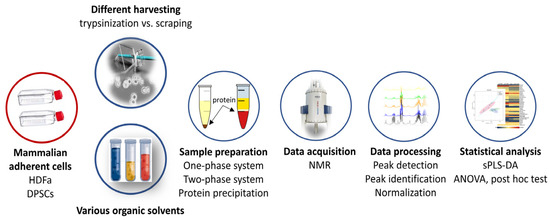Medicinal plant tissue cultures are potential sources of bioactive compounds. In this study, we report the chemical characterization of the callus cultures of three medicinal
Tilia spp. (
Tilia cordata,
Tilia vulgaris and
Tilia tomentosa), along with the comparison to bracts
[...] Read more.
Medicinal plant tissue cultures are potential sources of bioactive compounds. In this study, we report the chemical characterization of the callus cultures of three medicinal
Tilia spp. (
Tilia cordata,
Tilia vulgaris and
Tilia tomentosa), along with the comparison to bracts and flowers of the same species. Our aim was to show that calli of
Tilia spp. are good alternatives to the calli of
T. americana for the production of polyphenols and are better sources of a subset of polyphenolic metabolites, compared to the original organs. Calli were initiated from young bracts and grown on woody plant medium containing 1 mg L
−1 2,4-D and 0.1 mg L
−1 BAP. For chemical characterization, a quality-controlled untargeted metabolomics approach and the quantification of several bioactive compounds was performed with the use of LC-ESI-MS/MS. While bracts and flowers contained flavonoid glycosides (astragalin, isoquercitrin) as major polyphenols, calli of all species contained catechins, coumarins (fraxin, esculin and scopoletin) and flavane aglyca.
T. tomentosa calli contained 5397 µg g DW
−1 catechin, 201 µg g DW
−1 esculin, 218 µg g DW
−1 taxifolin and 273 µg g DW
−1 eriodictyol, while calli from other species contained lower amounts.
T. cordata and
T. tomentosa flowers were rich in isoquercitrin, containing 8134 and 6385 µg g DW
−1, respectively. The currently tested species contained many of the bioactive metabolites described from
T. americana. The production of catechin was shown to be comparable to the most efficient tissue cultures reported. Flowers and bracts contained flavonoid glycosides, including tiliroside, resembling bioactive fractions of
T. americana. In addition, untargeted metabolomics has shown fingerprint-like differences among species, highlighting possible chemotaxonomic and quality control applications, especially for bracts.
Full article
 IJMS
IMPACT
IJMS
IMPACT Applied Sciences
IMPACT
Applied Sciences
IMPACT Sustainability
IMPACT
Sustainability
IMPACT Sensors
IMPACT
Sensors
IMPACT JCM
IMPACT
JCM
IMPACT Materials
IMPACT
Materials
IMPACT Molecules
IMPACT
Molecules
IMPACT Energies
IMPACT
Energies
IMPACT Electronics
IMPACT
Electronics
IMPACT Remote Sensing
IMPACT
Remote Sensing
IMPACT Cancers
IMPACT
Cancers
IMPACT Nutrients
IMPACT
Nutrients
IMPACT Mathematics
IMPACT
Mathematics
IMPACT Foods
IMPACT
Foods
IMPACT Buildings
IMPACT
Buildings
IMPACT Polymers
IMPACT
Polymers
IMPACT Animals
IMPACT
Animals
IMPACT Water
IMPACT
Water
IMPACT Plants
IMPACT
Plants
IMPACT Agronomy
IMPACT
Agronomy
IMPACT Biomedicines
IMPACT
Biomedicines
IMPACT Processes
IMPACT
Processes
IMPACT Microorganisms
IMPACT
Microorganisms
IMPACT Diagnostics
IMPACT
Diagnostics
IMPACT Nanomaterials
IMPACT
Nanomaterials
IMPACT Viruses
IMPACT
Viruses
IMPACT Medicina
IMPACT
Medicina
IMPACT Healthcare
IMPACT
Healthcare
IMPACT Cells
IMPACT
Cells
IMPACT Forests
IMPACT
Forests
IMPACT Agriculture
IMPACT
Agriculture
IMPACT Land
IMPACT
Land
IMPACT JMSE
IMPACT
JMSE
IMPACT IJERPH
IJERPH
 Symmetry
IMPACT
Symmetry
IMPACT Genes
IMPACT
Genes
IMPACT Pharmaceutics
IMPACT
Pharmaceutics
IMPACT Coatings
IMPACT
Coatings
IMPACT Micromachines
IMPACT
Micromachines
IMPACT Pharmaceuticals
IMPACT
Pharmaceuticals
IMPACT Atmosphere
IMPACT
Atmosphere
IMPACT Children
IMPACT
Children
IMPACT Religions
IMPACT
Religions
IMPACT Antioxidants
IMPACT
Antioxidants
IMPACT Life
IMPACT
Life
IMPACT Metals
IMPACT
Metals
IMPACT Biomolecules
IMPACT
Biomolecules
IMPACT Vaccines
IMPACT
Vaccines
IMPACT Education Sciences
IMPACT
Education Sciences
IMPACT Minerals
IMPACT
Minerals
IMPACT Horticulturae
IMPACT
Horticulturae
IMPACT Brain Sciences
IMPACT
Brain Sciences
IMPACT JPM
IMPACT
JPM
IMPACT Bioengineering
IMPACT
Bioengineering
IMPACT














